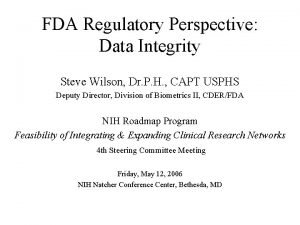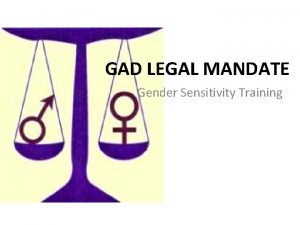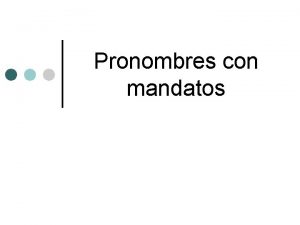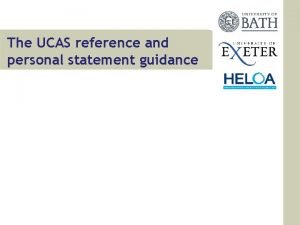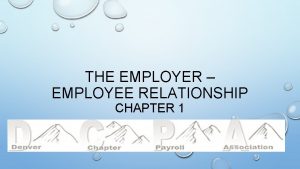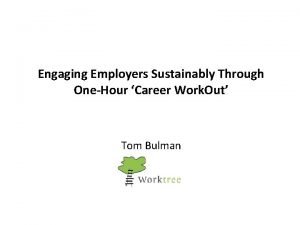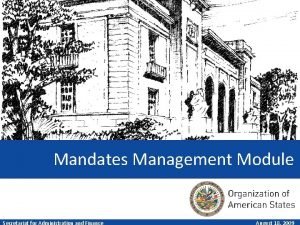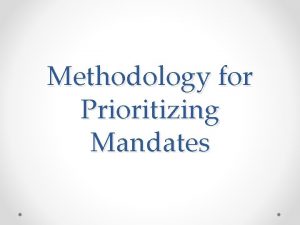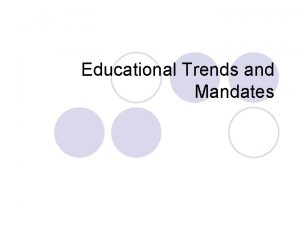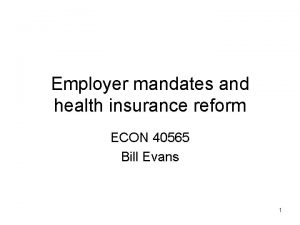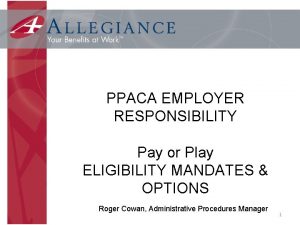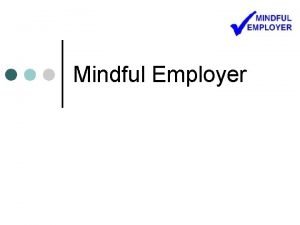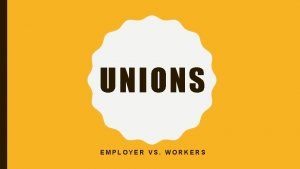The Access Crisis Are Employer Mandates Part of














- Slides: 14

The Access Crisis: Are Employer Mandates Part of the Solution? • Daniel Lasser, MD, MPH • April 25, 2007 Family Medicine and Community Health

Outline • Employment-based health insurance -- a brief status report • Employer mandates -- a possible solution to the health insurance crisis? • A brief look at the role of employer mandates in the Massachusetts plan • Challenges Family Medicine and Community Health

Employment-Based Health Insurance • Unlike most other industrialized nations, US policy has encouraged and subsidized the workplace as a primary means for managing access to health insurance – Rapid growth after World War II – Fueled by favorable tax policy – Began as social insurance, with community rating • Coverage has peaked – As a %: 2000: 66. 8% 2004: 62. 5% – Absolute #s: 2000: 164. 4 M 2004: 159. 5 M Family Medicine and Community Health

Health Insurance Coverage of the U. S. Population, 2005 Employer-based Direct Purchase Medicare Medicaid Total = 294 million Military/Other Not Covered Source: U. S. Census Bureau, Current Population Survey, 2005 Annual Social and Economic Supplement Note: Estimates by type of coverage are not mutually exclusive; people can be covered by more than one type of insurance during the year. Family Medicine and Community Health

Which one of the following is correct regarding medical insurance coverage in the U. S. ? * • The majority of persons 18 years of age or under are uninsured • The majority of uninsured persons come from working families • Medicaid coverage is available for all families with annual incomes below the poverty level • Health care workers are more likely than workers in other industries to have coverage • Hispanic families are more likely than African-American families to have coverage *2006 ABFM In-Training Exam Family Medicine and Community Health

Who is insured? • Individuals <18: 88% are insured • Individuals 65 or older: 99% are insured • Young adults 18 -20: 70% are insured • In 2002, 10. 5 million people below the federal poverty level were not insured by Medicaid Family Medicine and Community Health

Who is uninsured? • Considering ethnicity: – – 1/3 of Hispanic families are without coverage 20% of African-American families are without coverage 19% of Asian families are without coverage 11% of white families are without coverage • Health care workers and their families are more likely to be uninsured than workers in other industries • ~80% of uninsured families have at least one working family member Family Medicine and Community Health

Current Problems with Employment-Based Health Insurance • Fewer employees take coverage when it is offered – Some may even be eligible for Medicaid • Coverage has largely shifted from community rating to experience rating • With increased costs, more employers are dropping coverage – Smaller employers and those with predominantly low wage workers are unlikely to offer health insurance • There are problems with portability and provider continuity Family Medicine and Community Health

Current Problems with Employment-Based Health Insurance Family Medicine and Community Health

Employer Mandate • Models – Require all firms to offer health insurance (All? Above a certain size? ) – Play or play : Require firms that don’t provide health insurance to an employee to pay into a pool to support coverage from another source – Per employee – Based on a percentage of payroll costs – Require a penalty to be assessed to firms that do not pay or play • Hawaii requires nearly all employers to provide health insurance – Uninsured rate fell to 5% shortly after implementation; now ~10% • As of mid-2006, 28 states were considering pay or play legislation – 24 target employers with >1, 000 employees Family Medicine and Community Health

The Massachusetts Experience • 1988: Universal Health Care Law – $1680 Pay or Play Employer Mandate – Delayed 3 times, repealed in 1996 – Led to expansion of Medicaid, Student Insurance Mandate • 1996: Medicaid Waiver – Led to enrollee growth, coverage of all children, senior pharmacy program Family Medicine and Community Health

The Massachusetts Experience • 2006: Chapter 58 – Individual mandate: by 7/1/07, all 18+ must obtain health insurance • Penalties assessed if “affordable” coverage is declined – Expansion of Medicaid – Market reforms, “Connector” – Employer mandate • Non-offering employers (>10) pay 295/worker • Must offer section 125 “cafeteria plans” • Free rider surcharge – Employers with uninsured employees who are frequent users may be charged up to 100% of costs >$50 K – No charge if offering 125 plan Family Medicine and Community Health

Employer Mandate: Challenges • Economic concerns – Local: Economic disadvantage for employers in states who adopt mandates – Global: Economic disadvantage in competing with firms in countries without employer-based health coverage – Note: If combined with an individual mandate -employer premium costs may rise as non-participating employees opt in • Political lobby • Legal – ERISA pre-emption Family Medicine and Community Health

Conclusions • Employment-based health insurance is the predominant source of coverage in the US • In the current political environment, employer mandates may play an important role in expanding access to insurance • There will be a greater likelihood for success if combined with other approaches as well Family Medicine and Community Health
 Insidan region jh
Insidan region jh Fda data integrity presentation
Fda data integrity presentation Gad laws and mandates
Gad laws and mandates Pronombres con mandatos
Pronombres con mandatos Myasthenic crisis vs cholinergic crisis
Myasthenic crisis vs cholinergic crisis Branding
Branding Picture yourself as an employer or an employee
Picture yourself as an employer or an employee Ucas reference examples for teachers
Ucas reference examples for teachers Bates brand wheel for employer brand
Bates brand wheel for employer brand Employer-employee relationship
Employer-employee relationship Tony nelson's employer
Tony nelson's employer Workers rights and responsibilities
Workers rights and responsibilities Cornerstone employer
Cornerstone employer Largest employer in singapore
Largest employer in singapore Employer pays principle
Employer pays principle

